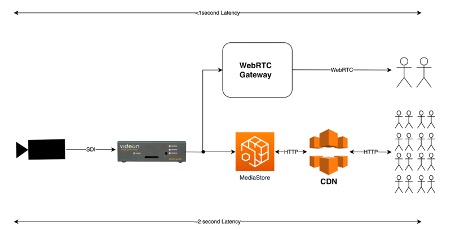Edge Computing: Powering a New Era of At-scale Ultra-low Latency for Sports Gamification
Gamification is changing how we consume live sports and opens a host of monetization opportunities for media and sports organizations

Gamification is changing the rules of the game for live sports, and this is the right time for media companies and sports organizations to take notice. Gamification brings greater fan engagement and more at-scale monetization opportunities that industry players need to notice.
Scale for live video means the number of feeds for any given event. So far, latency between the venue where the live sports takes place and the device where fans are watching the game has averaged around 30-40 seconds.
Therefore, live content hits the consumer platform 30-40 seconds too late, severely damaging the opportunities to create deep, meaningful, and lucrative fan engagement. Increased latency has resulted from existing complex cost-prohibitive workflows relying on the cloud to do the heavy-lifting when processing live feeds.
Edge computing for live video changes all this removing the challenges of latency in live streaming by simplifying workflows and augmenting the cloud by adding powerful processing capabilities at the point of video origin.
Edge computing at the source of live video creates a unified experience for live sports fans and betters, enabling broadcasters and sports leagues to engage their audiences consistently at scale. Live sports consumption turns from passive to active, allowing media and sports organizations to unlock more scalable monetization opportunities.
Why At-scale Ultra-low Latency is Critical for Live Video Monetization and Viewer Engagement
Live video has exploded, with streaming audiences in the U.S expected to reach 158 million in 2022. Live sports is one of the leading sectors driving this growth on several platforms. Broadcasters and sports organizations need to take advantage of live video’s exponential growth to harness monetization opportunities.
Today, we are already seeing live video platforms deliver active viewer engagement instead of the more traditional ‘passive’ linear TV viewing experiences. Live social commentary, betting, and performance tracking are examples of deeper fan engagement available at scale.
The professional video industry's #1 source for news, trends and product and tech information. Sign up below.
Live streaming workflows need to change to deliver compelling live sports content. The current methods of sending a live video feed to the cloud for processing create workflow complexity that increases latency and costs and degrades the video quality.
Ultra-low latency (ULL) is critical for sports gamification as any delays will result in poorer viewing delivery and limit the fan’s immersive experience. By overcoming the latency challenge, media and sports organizations can engage fans and encourage monetization through sports gamification at-scale.
Edge Computing: Augmenting Cloud Capabilities and Driving Monetization
Research has shown that in 2022 197 million US adults will watch content on a second device while watching a digital video or traditional TV. A second screen is becoming an essential source of personalized content for audiences that can consume content on the platform they want—often in conjunction with a linear program. It creates an excellent opportunity to pioneer secondary, often lightly-produced, content, including different camera feeds or commentary options typically accompanied by on-screen statistics and graphics. These complementary options enable viewers to have a gamification experience, providing an extra layer of game insight and data analytics.
But for this to happen, media companies need to ensure the live content reaches consumers with ultra-low latency. A video edge computing platform can revolutionize live streaming workflows, putting advanced compute capabilities and processing power on-premise, right at the source of the video, instead of relying on the cloud to do the heavy lifting.
Changing how we package live video feeds to bypass or augment cloud functions can enable direct output of HLS and DASH in a low-latency format. The feeds can then be pushed into the CDN and delivered to viewers worldwide. These scalable workflows can be simultaneously adapted to HTTP, SRT, or WebRTC, providing the same ULL.
A video edge computing platform also addresses the OPEX challenge, shaking up the economics of the cloud. By optimizing their dependence on the cloud, media companies can perform and complete critical processing tasks on-premise in a standards-based streaming environment.
In addition, organizations can take advantage of edge computing’s scalability and build and deploy the functions they require — customizing their platform to meet their business needs today and in the future. Workflows become simplified as the steps to send feeds to and from the cloud are removed from the delivery chain.
Depending on the use case, this reduces latency dramatically to less than 3 seconds or even sub-seconds. Let’s take the example of Web RTC. Bypassing the cloud directly to a Web RTC Gateway can bring latency down to sub 1 second. Audiences get an experience of improved quality, less latency, and a unified experience across various platforms at scale. In today’s ever-competitive market, this can give video producers a much-needed edge as it delivers the fan the experience they want in a scalable and unique way.
Harnessing Gamification and Fan Engagement with Edge Computing for Live Video
Gamification is changing how we consume live sports and opens a host of monetization opportunities for media and sports organizations — provided they resolve the critical latency challenge and achieve real-time content delivery.
A video edge computing platform revolutionizes live streaming workflows by creating powerful computing and processing capabilities on-premise, at the source of live video. Therefore, an encoder no longer needs to send live feeds to the cloud for processing before reaching a CDN. The live video delivery chain becomes shorter, simpler, and more efficient. Media companies optimize costs and deliver content to the consumer with ULL creating consistent fan engagement — and scalable monetization doors open up for live sports gamification.
We’ve only begun to scratch the surface of what gamification and consistent fan engagement can bring to the media and broadcasting industries. As the growth of live video explodes, a video edge computing platform that delivers at scale changes the realm of possibilities for media and sports organizations, bringing new viewing and at-scale monetization opportunities that we can’t afford to miss.

